Donald Sheldon Overturf and Josephine Marie Hansen 50 Years Together
Editor's Note: When you see these three dots surrounded by a gray rectangle — 1 — you can click on it to get further information about the topic. Click a second time, and the message goes away.
Donald Sheldon Overturf (1916-1998) and Josephine Marie Hansen (1917-1988)
Hometown: Hastings, Nebraska
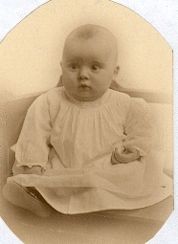
Donald Sheldon Overturf was born in Hastings, Adams County, Nebraska, on 10 July 1916 in his parents' home on the southwest corner of 9th and Bellevue. He was the second son for George Edwin and Nellie Allison McDonald Overturf. Don's older brother, Lee, was already four years old, and his younger brother, George Jr., would not come along for another eleven years. In July of 1916, war had been raging in Europe for two years, but the United States, led by Woodrow Wilson, was still neutral and would not involve itself for yet another six months.
Don's mother, Nellie Allison McDonald Overturf, wrote the following description of her son in 1960: "Don has brown eyes, curly light brown hair, and is of small stature [5'7" tall], like his mother. He also has a cleft in his chin, like his mother. He usually weighs 145 or 150 pounds."
Academics, Athletics, Singing — Don did them all with enthusiasm!
As a middle child, Don seemed most interested in getting the attention of his parents and anyone else who might want to take notice of him. He was an above-average student, usually excelling academically; an eager athlete in football, basketball, and track; and possessed an excellent tenor voice. His greatest academic success was earning his Ph.D. from the University of Nebraska in 1960, the first in his family to achieve such a degree. His greatest athletic success was participation for several years on a college basketball team, and his greatest vocal success was winning the highest award for male tenor voice in the state of Nebraska in 1934. He won the Bronco Award in his senior year (1938) at Hastings College, an award given to the top all-round student, excelling academically, athletically, and socially. He was also named to Who's Who.
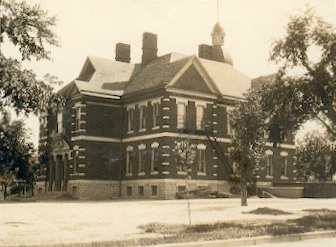
Don attended elementary and secondary school in Hastings. (At left, Longfellow elementary School, in Hastings, Nebraska.) In junior high and high school, he played basketball, ran track and enjoyed gymnastics; he also participated in student government. He graduated from Hastings High School in 1934 and from Hastings College, receiving his BA degree in education, in 1938.
While in high school and college, he performed in school plays, held numerous elected positions with the student body, and participated in three sports. In his senior year of high school, he broke his collar bone in a football game and decided at that time that he was too small for football. In college, he was well-known in the community for his activities on the basketball court, where he was usually in the starting line-up and his fast get-aways usually left the other players behind. He was one of the top scorers on the team in any game.
Don also loved his cars. At one point he had a Nash coupe that, his younger brother says, gave him a lot of trouble. He always worked on his own cars — to save money — and this was no exception, even in his youth. One day he worked on a brake job for his Nash coupe. He did what he thought he had to do, took the jack off, and jumped in the car and started the motor. He roared up the driveway toward the garage, but when he slammed on the brakes, nothing happened. The car went right through the back of his dad’s garage! He had failed to put fluid in the hydraulic brakes. Fortunately, Don’s father always managed to see things in a positive way: He said the garage was too short anyway and so he rebuilt it with a space for the Buick hood to fit into it nicely. Finally, they could shut the garage doors!
Special Girl: Josephine
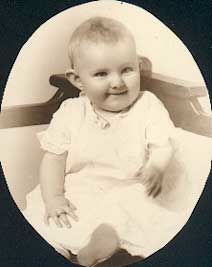
Don met Josephine Marie Hansen when they were both still in elementary school. By his junior year in high school, he had asked her out, though they usually got together with a large group of friends.
Josephine Marie Hansen was born on 21 June 1917, in Hastings, Adams County, Nebraska. She was the only daughter of Hans Lloyd Hansen and Estella Mary Mahoney. Bill, her younger brother, was born two years after her, and her other brother, Jim, was born ten years after Bill. [For some interesting stories of Bill's experience in World War II, go to Uncle Bill in World War II.
Josephine, who was usually called Jo (and sometimes Josie and Jody), was tall at 5'8', blue-eyed, and a blonde whose hair turned brunette as she grew older.
She — like Don — also succeeded at all she tried
Josephine attended Morton Elementary School until the third grade and then Longfellow Elementary School. She was promoted after a half year of kindergarten and again another half year after fourth grade, so she skipped a year of elementary school and caught up with Don in the sixth grade. She always liked school and had no difficulty with most of the school subjects. She participated in numerous vocal musical activities. Also in grade school, she loved to play running games. As a youngster, she was very thin, and she succumbed to numerous childhood illnesses.
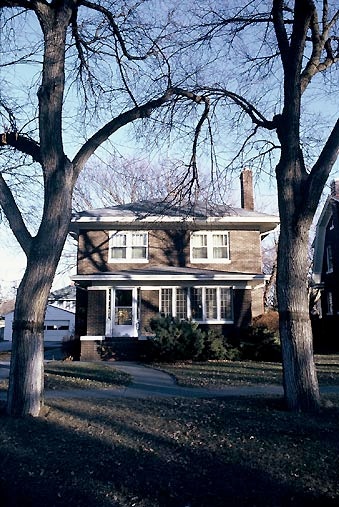
Jo's father, Hans Lloyd Hansen, built a home for the family at 1010 North Burlington (shown at right) and when Jo was in the third grade, she moved into that home with her family. It remained the family home until Jo's mother, Stella, died in 1967. The home was large and extravagant for its time. Built of brick, it had two floors and a large basement. The main floor had a living and dining room, a large kitchen, and a small den for Jo’s father. Upstairs were four bedrooms and a bathroom. The basement included a large recreational room with a laundry and pantry off to one side. A garage in the backyard kept the family car protected, and Stella liked her back garden with lots of flowers.
In junior high and high school, Jo belonged to a group of friends who corresponded with her until her death. As teenagers, they often played bridge together. Jo took piano and dancing lessons, both of which she loved. Voice lessons came when she was in college. She graduated from Hastings High School in 1934, ranking ninth scholastically in a class of 220. During these years of public schooling, there were many family get-togethers with the Mahoneys in Heartwell and the Hansens in Minden. The Mahoneys were a large, rowdy bunch. Things were a little more staid and sedate at the Hansens, although Jo's father was well-known for his practical jokes.
Jo, like Don, attended Hastings College. In 1934-35 and 1935-36, they dated and hoped that her father would "come around" and let them marry. Jo worked part-time as a clerk in the Ben Sherman Clothing Store. Ben had been a neighbour, and he was good to Jo. Jo and Don’s secret relationship was a challenge for them, and they often enlisted the help of their friends. After two years of college, Jo and her father had a serious argument over her involvement with Don and he withdrew his financial support to her.
Jo felt there was nothing else she could do but leave and teach for a year, earning enough money to get her through the next year of school. She taught grades one through four for a year in a small school in Lowell, Nebraska while Don continued his education at Hastings College. This was the 1936-37 school year. Jo apparently had at least one other suitor, but not as persistent or as serious as Don; she even kept a couple of this young man's letters her entire life.
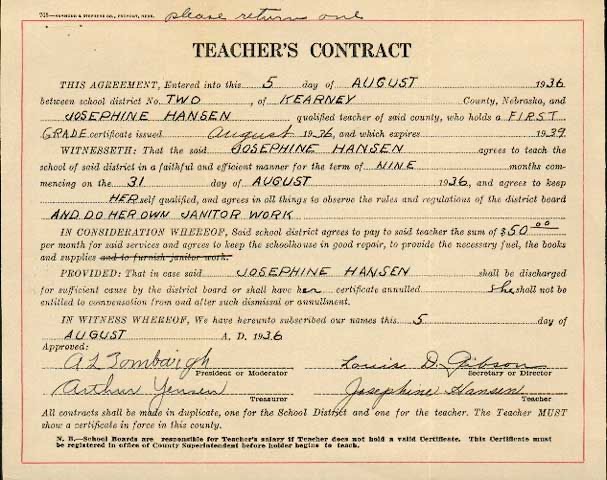
A Few Bumps along the Way to Happiness
Don and Jo’s relationship ran into troubles early because Josephine's father did not approve of Don as a future husband for his daughter. Despite numerous attempts to win him over, the young couple eventually felt it was necessary to elope, which they did on 20 June 1937, in Greeley, Nebraska. They kept their marriage a secret for more than a year as it was during the Great Depression, and they could not afford to continue college and also set up housekeeping. As well, their marriage could have been annulled by Josephine's father since they had married underage and without parental consent.
Once they were both 21, they revealed their marriage. Don's mother, Nellie, had known about the marriage almost from the beginning, however, as she had found the marriage certificate in her son's bureau drawer when she was putting away his clean clothes. After they announced their marriage, Jo's parents accepted it and had several announcements and parties in their honor. Jo was even featured in a newspaper article.
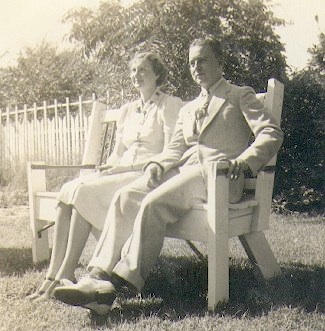
At the right is a photograph of Jo and Don on the day they announced their marriage. It was taken in the backyard of Don’s parents’ home at 839 North Kansas Avenue in Hastings, Nebraska. Don’s father — George Edwin Overturf — had built the bench heavy enough so that even he could sit on it. There were numerous photographs taken of them sitting on this bench.
Afterwards, Don and Jo went on a honeymoon, driving the same route that Don had driven with his buddy in 1934 right after high school. They went to the Washington, D.C. area and back.
Finishing College and Starting a Career
During those final two years of college, Jo worked as a student aide in the history department, grading papers for Mrs. Dean for twenty-five cents per hour. At the end of her junior year, which was the end of Don's senior year, they announced their marriage and moved to Harvard, Nebraska. This was twenty miles from Hastings and was the first teaching position for Don; he taught English and journalism. During that final year, 1938-39, Jo commuted to Hastings with a long-time friend, Vi Givens, and earned her BA degree cum laude (with majors in elementary education and English and a minor in history). While in college, Jo was involved with the Hastings College Choir (as was Don), Presbyterian Church Choir, Kappa Rho (women's society group), YWCA, and secretary of the student government. Sometimes, she played basketball as well with her group of girlfriends.
Family Begins and War Interrupts
Don and Jo moved to Norfolk, Nebraska, in August 1939 where their first child, a daughter, Karen 2, was born on December 5th. For the next several years, Jo was busy with being a wife and mother, while Don taught English and journalism and worked on his Master’s degree. Their second child, another daughter, Kathie 3, was born in Norfolk on 29 March 1942. Don finished his Masters degree at the University of Nebraska in the summer of 1942 and they moved to California where Don accepted a position at Santa Ana Junior College.
While the world was at war from 1939 to 1941, Don and Jo (like most other Americans) tried to keep their lives on track, starting a family and improving Don's education so he could earn a higher salary. After Pearl Harbour, it was particularly difficult for Don to stay out of the war effort, but with a wife and two children and a career in education, Don was able to get fatherhood and occupational deferments.
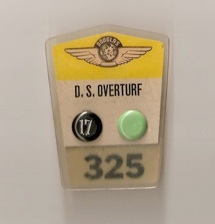
By the time he accepted the position at Santa Ana Junior College in California, Don was greatly bothered by the fact that he was not involved in some way in the war effort. By the spring of 1943, he requested to be released from his contract, and this was granted. He went to work for Douglas Aircraft in Long Beach, California, as a supervisor of the Office Day Shift. His badge, which he used while working at the plant, is shown at the right. He gave this to his younger brother, George, after the war. The plant built A26 bombers, as well as DC3’s and C47’s. Don gave his younger brother, George, the print of an A26A Invader by Joe Milich of Denver, Colorado.
Money was so tight that Don asked his father and younger brother to crate up his Iver Johnson bicycle in Nebraska and send it to him in California, so that he could ride his bike to work while Jo had the car to get the kids around and to do shopping. The bike had 28-inch wheels with single-piece tires which had to be glued on the rims. With a rubber shortage during the War, there were no tires made for anything civilian, including bicycles. Don had to “make do” with what he had.
On 27 November 1943, Jo gave birth to their third child and first son, Gary 4. They moved back to Orange, California, where they remained until the end of World War II.
Getting Back on Track: Wood Lake, Nebraska
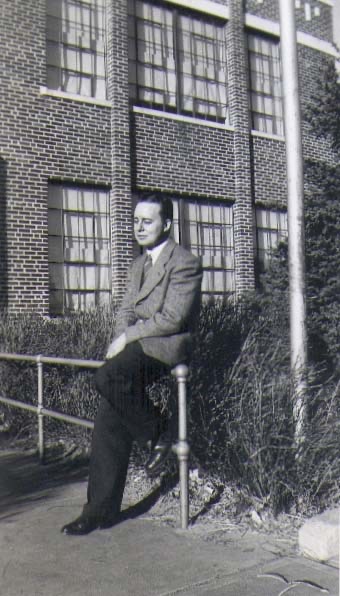
After Victory in Japan had been announced, Don and Jo tried to return to their lives as it had been before the war. With three children under the age of six and a fourth child on the way, they packed their car and drove to Nebraska where Don took a position as superintendent of a small school system in Wood Lake, Nebraska. One month later, their fourth child, third daughter, Susan 5, was born at Valentine, Nebraska, on 4 October 1945.
The school system in Wood Lake was in poor shape after four years of war. Housing was in short supply, most young men had gone to war, and many others had left to find employment in the cities. In the photograph at the right, Don is standing before the school building which housed all of the children from primary to secondary. Jo attempted to cope with the poor housing and four children under the age of six. But both of them must have known that this stay in Wood Lake was going to be temporary.
Moving on: Fairbury, Nebraska

Don, Jo, and the kids tried to make the best of things — the house was old and rundown — but, in April of 1946, Don resigned as superintendent to accept a position with Fairbury Junior College as its dean. Because of no housing in Fairbury, Jo stayed in Hastings with the four children (first with her parents and then with Don's parents). In the summer of 1946, the entire family moved to Crete, Nebraska, to a summer camp retreat while Don began work on his doctorate at the University of Nebraska.
At long last, in the fall of 1946, the family moved to Fairbury where they stayed until 1949. A photograph of the home they lived in is at the left. It was taken in the 1980’s, but looks much the same as it did in the 1940’s (except the tree is bigger!).
While in Fairbury, Jo engaged in some church activities and sang at times with a vocal trio. She sang "I know that my Redeemer Liveth" at the Easter program, and Stella, her mother, came from Hastings to hear her. For one semester, she taught English at Plymouth High school in Plymouth, Nebraska, which was a short commute. She was rehired but she found it too difficult to handle four children who were still very young and also teach, so she did not continue.
A big change and a step up in Don’s Career: Silver City, New Mexico
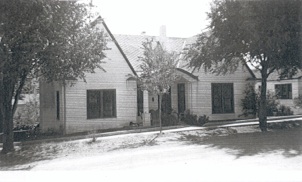
In 1949, Don joined the faculty and administrative staff of Western New Mexico University (it was called New Mexico Western College at that time) in Silver City, New Mexico. They would remain in Silver City for twenty years and this is the small town that their children considered home. They lived in a small duplex, and then a larger rental home, but in 1952, they bought a home at 1105 West 6th Street (shown at right). This would be their home until 1969. Don spent many hours working on this home, adding a patio and deck, building a fence around it, eventually changing the attic into a second floor (including building a stairway).
Jo went to school at the college and earned her Masters Degree in 1952 (earning A's in every subject she took). While working on her degree, she did substitute teaching jobs in the Silver City schools.
Don’s New Position and Continuing Education
Don began at Western as Registrar and Dean of Men. He quickly established a reputation as a man of integrity and honesty. He worked well with both students and staff, and he was extremely popular. He was somewhat of a visionary, constantly seeking to organize and improve his office's efficiency. In the 1950s, he was responsible for the purchase of an auto-typist machine which could type pre-programmed paragraphs to persons writing to inquire about Western or its educational programs. (In essence, it was an early computer.)
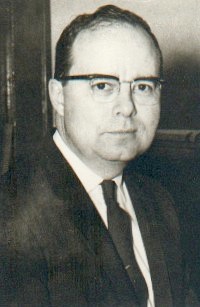
Don was also instrumental in making sure that Western established the requirements to be a university. New Mexico Western College eventually became Western New Mexico University. He was considered for the presidency of the university at one time, but he turned this down. At the end of his service to Western, Don held the second-highest position in the university administration, Dean of Student Affairs. For a short space of time, he also held the position of Dean of Academic Affairs when the person hired for that position was too ill to do the job.
In 1960 Don earned his Ph.D. from the University of Nebraska. His thesis was titled “The History of New Mexico Western College”. The University of Nebraska has this document on file, and it can be purchased. A 24-page preview of it is also available. It can be found at this link.
Jo’s 17-Year Teaching Career
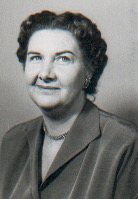
In the early 1950s, teachers were very much in demand, and Jo resumed a teaching career in 1951 with the Grant County Schools. Her first annual teaching salary was $3150, considerably more than the $500 she had earned in Lowell, Nebraska in 1936-37. She was given an assignment in Fierro, New Mexico, a small mining community about fifteen miles from Silver City. She taught mostly in the third to fifth grade levels, and most of her children were of Hispanic descent, the children of the miners living in the community. Jo loved to use her music in teaching. She had a piano in her room and used music often at the annual Christmas program, including a rhythm band.
For eight long years, Jo commuted to Fierro to teach in an old school at the top of a big hill. It had not always been easy — a difficult commute in winter driving conditions, children from very poor home situations, and a lot of time away from her family — but she also said that she "found great satisfaction in the classroom" and "it gave [her] a sense of independence that [she] relished." The photograph at the left was taken during Jo’s career at Fierro.
Finally, Fierro School consolidated with the Cobre Consolidated School System and Jo was assigned a sixth grade glass at Hurley, New Mexico. She stayed there for four years and then asked to be assigned to a school closer to home. She taught third grade at Bayard, New Mexico, for five years.
Involvement in Other Activities
Both Don and Jo were active in the community: the Presbyterian Church and various other organizations. Jo was a member of the DAR and the American Association of University Women. In the late 60's, they built a cabin near Lake Roberts in the Gila National Forest. Don did quite a bit of the inside work on his own. They liked going there to get away from the telephone.
Change in Lifestyle
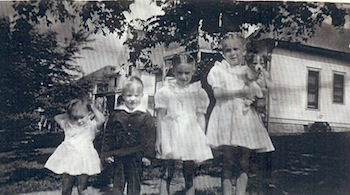
This photograph of the Overturf children, taken in 1948 in Fairbury, Nebraska, shows them, from left to right: Susan, Gary, Kathie, Karen. By the end of 1966, Jo and Don's children were all married, and they now had four grandchildren. All four children graduated from Western New Mexico University and three of the spouses also graduated from there. At the end of 1966, their youngest daughter had married and they were a couple again — after twenty-seven years.
Jo continued to teach while Don continued his responsibilities at Western New Mexico University. In 1968, Don became very ill with Shingles and was hospitalized. Jo resigned from her teaching position with Cobre Schools, believing that she could become a part of the Silver City Schools. But no job materialized and she was home for a year. In July of 1969, Don resigned from Western New Mexico University, "under very difficult conditions," according to Jo. Don, at age 55, believed that he would be able to easily find another job, but it took him six months to do so.
End of career: Northern Arizona University in Flagstaff, Arizona
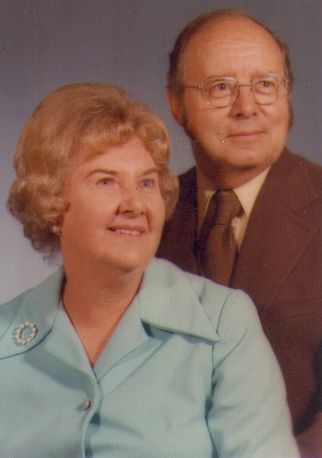
In January of 1970, Don accepted a teaching position at Northern Arizona University in Flagstaff, Arizona. Since they were not certain if they would stay, they purchased a double-wide trailer and lived in a trailer park for several years. Jo attended one class in library science, thinking that she might try for a doctorate, but the thirty hours she had earned past her Master's degree had to be scratched, and she was told she would have to start all over again. Instead, she sold Avon products for three and a half years, always a member of the President's Club, a club based on selling so many dollars' worth in a given time. Eventually, she began to work as a volunteer in Don's office since she wanted to be as close to Don as possible. They worked together until his retirement on 1 July 1981.
At NAU, Don taught several courses in education and was assistant to the Dean of Arts and Sciences. As at Western, he was well-liked and popular with both staff and students. At this time, he received Emeritus membership in Phi Delta Kappa. When Don retired, a reception was held for both him and Jo.
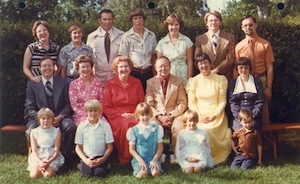
In 1977, Jo and Don celebrated their 40th wedding anniversary and the entire family of four children, their spouses, and eight grandchildren met at the oldest daughter’s home in Denver, Colorado, for a celebration and reunion.
In 1978, Don and Jo purchased a home in Sedona, Arizona, and they commuted from there for a few years before Don's retirement.
Retirement
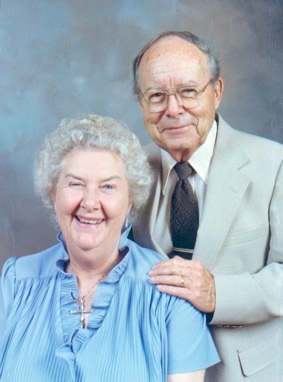
Don and Jo lived together in retirement in Sedona from 1981 until Jo's death on 31 July 1988. In earlier days, they had enjoyed using a camper trailer, but after retirement they preferred motels. They took at least two trips to Europe, and they returned to Hastings, Nebraska, for several school reunions. They had more time for visits with their aging siblings as well.
In the summer of 1987, Don suffered a severe stroke which left him speechless (aphasia), unable to use ordinary tools (apraxia), and partly paralyzed on the right side. This occurred just shortly before their planned celebration of their 50th wedding anniversary. Despite this, they did have a small celebration. The photograph at left was taken to celebrate their 50th anniversary.
Jo found her caretaking role difficult, and it probably contributed to her death, although she also suffered from diabetes and high blood pressure. She complained for nearly two days that she did not feel well, but they drove to Silver City to spend time at their cabin at Lake Roberts anyway. They returned early because of Jo's illness. Once home, she felt a little better. When the attack occurred, she only had time to call Don for help, he dialed 911, she spoke to the 911 operator, and then put down the phone. By the time the ambulance arrived, she was, for all intents and purposes, gone.
Life without Jo

For Don, the first year after Jo's death was a difficult one, although he did manage to go to visit each of his children. By the second year, however, he had to deal with cancer (a tumor in his neck). While undergoing treatment, he lived with his son, Gary, and his daughter-in-law, Carol, in Los Angeles, California. Eventually, he returned to his home in Sedona where he lived with his daughter and her husband in his own home. Shortly before he died, he had gone to live in an assisted-living facility. He died on 20 August 1998, and is buried beside Jo in the Sedona City Cemetery.
Susan, the youngest child of Don and Jo, remembers her father as a loving and kind person. He was a great story-teller and perpetually optimistic about life. As a child, Susan followed him as he worked on his many projects around the house or with his car. She developed a strong appreciation for his intelligence and skills. She felt that her mother was much more complex than her father and, as a child, she never felt close to her mother. In later years, however, Susan came to appreciate her mother and the obstacles she had overcome in life. She also learned to appreciate her mother’s sense of humour and that twinkle in her eye.
Despite problems in their marriage, Jo and Don demonstrated over and over again their loyalty to each other and to their marriage vows. People who didn't know them well would say that Jo was a "bit stand-offish" and that Don was "friendly and a nice guy." These were, indeed, the traits people first noticed about them. Without a doubt, however, both of them had a gigantic influence on the hundreds of students they taught, in addition to their own children. It is hard to say why lives are important or worthwhile, but Jo and Don Overturf certainly worked hard to be worthy, to help others, and to endure heroically and without complaint the trials that life brought them. Perhaps those are their greatest achievements.
[This page researched and written by Susan Overturf Ingraham, a daughter of Don and Jo. Last updated May 25, 2023.]
-
These three dots behave exactly like a footnote. Click on them and you will get more information about the topic. ↩︎
-
Karen would marry Bobby Carol Hatler (1937-?) on 26 May 1959 in Silver City, New Mexico. They would have four children: Marlayne, Bruce, Brett, and Brain. ↩︎
-
Kathie would marry Jerry Dwaine Wagner (1942-?) on 20 December 1963 in Silver City, New Mexico. They would have two daughters: Kristina and Tracey. ↩︎
-
Gary married Carol Ann Schmidt (1944-?) on 19 December 1965 in Albuquerque, New Mexico. They had one daughter: Anne. ↩︎
-
Susan Married Robert Philip Ingraham (1943-?) on 27 December 1966 in Silver City, New Mexico. They had one son: Paul. ↩︎